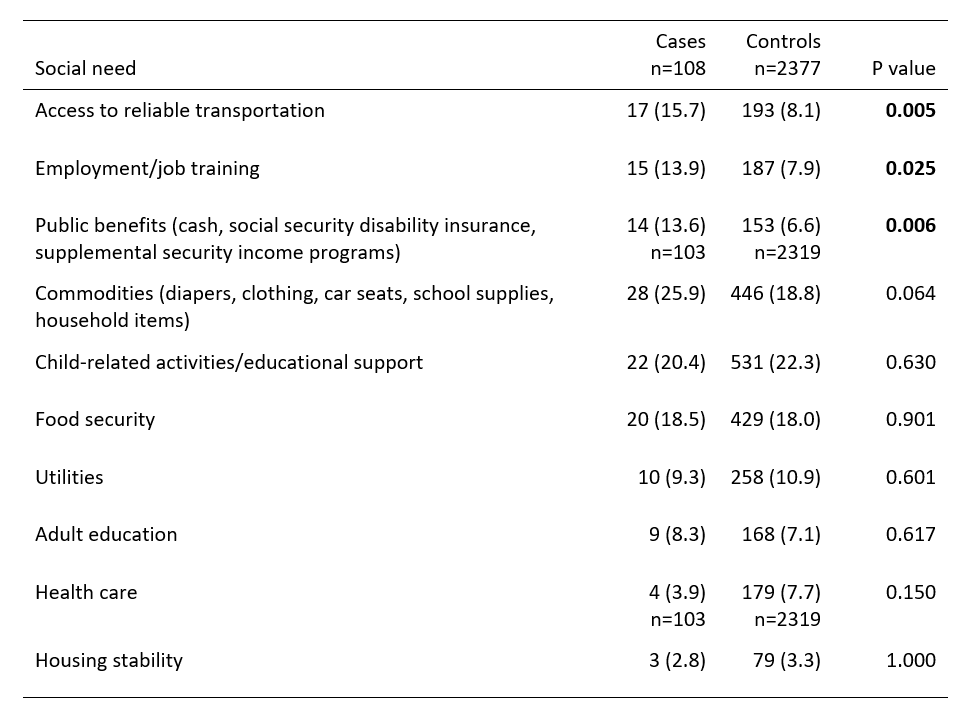Child Abuse & Neglect
Category: Abstract Submission
Child Abuse & Neglect I
225 - Social Needs Identified in Families with Reports of Child Maltreatment
Monday, April 25, 2022
3:30 PM - 6:00 PM US MT
Poster Number: 225
Publication Number: 225.401
Publication Number: 225.401
Jonathan Thackeray, Dayton Children's Hospital, Dayton, OH, United States; Adrienne Stolfi, Wright State University, Dayton, OH, United States; Bridget Hobbs, Dayton Children's Hospital, Dayton, OH, United States; John Pascoe, Wright State University Boonshoft School of Medicine, Dayton, OH, United States; Shivani Dighamber, Wright State University Boonshoft School of Medicine, Beavercreek, OH, United States
- JP
John Pascoe, md mph (he/him/his)
Professor
Wright State University Boonshoft School of Medicine
Dayton, Ohio, United States
Presenting Author(s)
Background: There are known associations between a family’s social needs (such as food insecurity, housing instability, and lack of access to transportation) and the frequency of adverse childhood experiences (ACEs), including child maltreatment. Although the relationship between social needs and ACEs is well-established, putative differences in the social needs of families who do or do not have a child reported for maltreatment have not been carefully studied.
Objective: The objective of this study is to identify differences in the number and types of families' social needs for children reported for child maltreatment compared to families of children not reported for child maltreatment.
Design/Methods: This study is a case-control analysis of children receiving care at a primary care medical home affiliated with a tertiary care academic hospital. At each well-child visit, caregivers complete a screen that captures ten distinct social needs. Cases are defined as caregivers of children with a hospital-initiated child abuse report and at least 1 social needs screen completed within 12 months before or after the date of the abuse report. Controls were randomly selected and frequency matched on number of screens completed, child age category, gender, race, insurance, and whether the social needs screen was completed during the COVID pandemic. Cases and controls were compared with chi-square or Fisher’s exact tests, or Mann-Whitney test.
Results: Between 1/1/2017 and 12/31/2020, 4875 caregivers completed one or more social needs screens. From this dataset, 108 cases and 2377 frequency-matched controls were identified. Of this group, 1219 (49.1%) were black, 2163 (87.0%) were publicly insured, and 1565 (62.9%) were less than 5 years of age at the time of screening. The percentage of caregivers with at least one positive screen (52.8% vs. 45.9%) and the mean number of social needs identified per caregiver (1.6 vs. 1.5) did not differ significantly between cases and controls. Caregivers of cases were more likely to identify lack of access to transportation, need for employment/job training, and need for public benefits than controls (see table). Identification of other social needs, including food insecurity and housing instability, did not differ between cases and controls.Conclusion(s): In this study, specific social needs were associated with reports of child maltreatment. Conducting social needs screening is a mechanism for identifying ways to better support caregivers and improving understanding of social needs may identify opportunities to reduce child maltreatment.
Table. Number (%) of cases and controls identifying social needs
Objective: The objective of this study is to identify differences in the number and types of families' social needs for children reported for child maltreatment compared to families of children not reported for child maltreatment.
Design/Methods: This study is a case-control analysis of children receiving care at a primary care medical home affiliated with a tertiary care academic hospital. At each well-child visit, caregivers complete a screen that captures ten distinct social needs. Cases are defined as caregivers of children with a hospital-initiated child abuse report and at least 1 social needs screen completed within 12 months before or after the date of the abuse report. Controls were randomly selected and frequency matched on number of screens completed, child age category, gender, race, insurance, and whether the social needs screen was completed during the COVID pandemic. Cases and controls were compared with chi-square or Fisher’s exact tests, or Mann-Whitney test.
Results: Between 1/1/2017 and 12/31/2020, 4875 caregivers completed one or more social needs screens. From this dataset, 108 cases and 2377 frequency-matched controls were identified. Of this group, 1219 (49.1%) were black, 2163 (87.0%) were publicly insured, and 1565 (62.9%) were less than 5 years of age at the time of screening. The percentage of caregivers with at least one positive screen (52.8% vs. 45.9%) and the mean number of social needs identified per caregiver (1.6 vs. 1.5) did not differ significantly between cases and controls. Caregivers of cases were more likely to identify lack of access to transportation, need for employment/job training, and need for public benefits than controls (see table). Identification of other social needs, including food insecurity and housing instability, did not differ between cases and controls.Conclusion(s): In this study, specific social needs were associated with reports of child maltreatment. Conducting social needs screening is a mechanism for identifying ways to better support caregivers and improving understanding of social needs may identify opportunities to reduce child maltreatment.
Table. Number (%) of cases and controls identifying social needs

